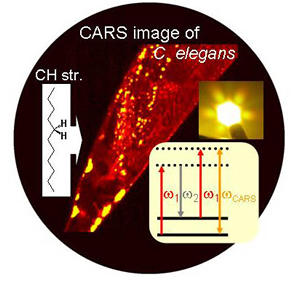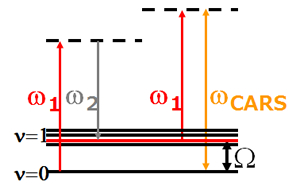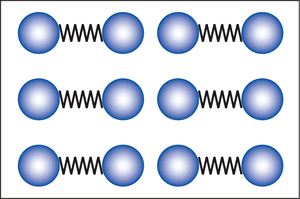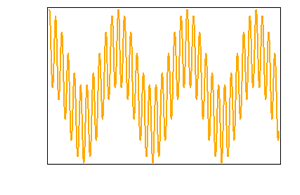What Is CARS?

At Kano Lab, we are working to develop new spectroscopy and imaging technologies based on nonlinear interactions between light and materials. Our current interest is the use of coherent anti-stokes Raman scattering, CARS, among others.
CARS is a nonlinear Raman process that is now most widely used for vibrational spectroscopy. Figure 1 shows the CARS process. CARS uses two laser beams, a pump beam and a Stokes beam at different wavelengths (ω1 and ω2). When the frequency difference between these two beams, ω1-ω2, matches the frequency of one of the vibrational modes, W, of the molecules in a sample, many of these vibrational modes become excited simultaneously. This results in coherent molecular vibrations which interact with a third laser beam called a probe beam with a frequency of ω3 and in turn generate ωCARS signals through the third-order nonlinear polarization. In accordance with the law of conservation of energy, this frequency is expressed by: ωCARS = ω1-ω2 + ω. To fulfill the phase-matching conditions, the CARS signals is generated in the direction of: kCARS = k1 – k2 + k3, where k1, k2 and k3 are the frequency vectors of ω1, ω2 and ω3, respectively. The pump beam is often used as a probe beam. In this case (ω3 – ω1 ), the intensity of ωCARS signal is proportional to the square of the ω1 beam intensity and directly proportional to the ω2 beam intensity. That is, the intensity of ωCARS signal increases NONLINEARLY (!) with the pump beam intensity. The phase-matching conditions ensure the good directionality of Raman scattering with the CARS process.

Figure 1
Figure 2, left : Two laser beams induce and resonantly enhance molecular vibrations.
Figure 2, right: Such molecular vibrations are coherent and driven by the frequency component, ω1 – ω2 (also called the beat frequency), between the two beams. This figure shows a time-domain waveform generated by the product of two optical electric fields (single-color beams). There are rapid (sum, ω1 + ω2) and slow (difference, ω1 – ω2) vibration components, and the slow component is used to induce molecular vibrations in CARS.







